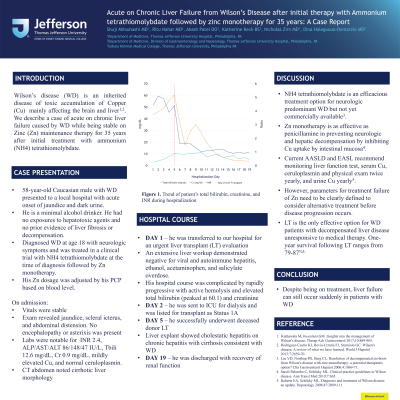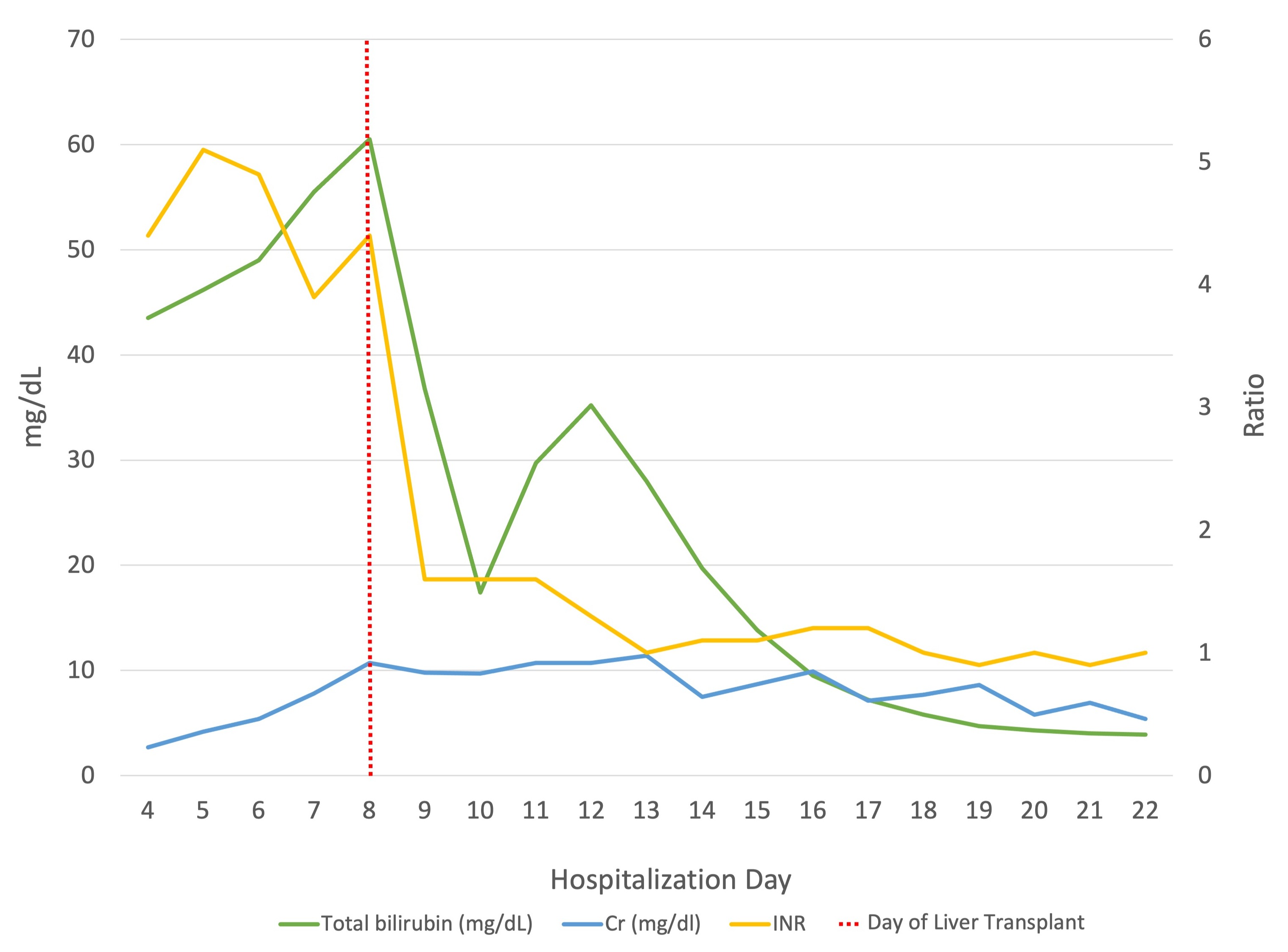Back


Poster Session B - Monday Morning
Category: Liver
B0558 - Acute on Chronic Liver Failure From Wilson’s Disease After Initial Therapy with Ammonium Tetrathiomolybdate Followed by Zinc Monotherapy for 35 Years: A Case Report
Monday, October 24, 2022
10:00 AM – 12:00 PM ET
Location: Crown Ballroom

Has Audio

Shuji Mitsuhashi, MD
Thomas Jefferson University Hospital
Philadelphia, PA
Presenting Author(s)
Shuji Mitsuhashi, MD1, Ritu Nahar, MD1, Akash Patel, DO2, Katherine Keck, BA3, Nicholas Zirn, MD2, Dina Halegoua-DeMarzio, MD1
1Thomas Jefferson University Hospital, Philadelphia, PA; 2Thomas Jefferson University, Philadelphia, PA; 3Sidney Kimmel Medical College at Thomas Jefferson University, Philadelphia, PA
Introduction: Wilson’s disease (WD) is an inherited disease of toxic accumulation of Cu mainly affecting the brain and liver. We describe a case of acute on chronic liver failure caused by WD despite being stable on Zn maintenance therapy for 35 years after initial treatment with ammonium (NH4) tetrathiomolybdate.
Case Description/Methods: A 58-year-old Caucasian male with WD presented to a local hospital with acute onset of jaundice and dark urine. He is a minimal alcohol drinker. He had no exposures to hepatotoxicity and no prior evidence of liver fibrosis or decompensation. He was diagnosed WD at age 18 with neurologic symptoms and was treated in a clinical trial with NH4 tetrathiomolybdate at the time of diagnosis followed by Zn monotherapy. His Zn dosage was monitored by his PCP based on its level.
On admission, his vitals were stable. Exam revealed jaundice, scleral icterus, and abdominal distension. No sign of encephalopathy or asterixis. Labs were notable for INR 2.4, ALP/AST/ALT 86/148/47 IU/L, Tbili 12.6 mg/dL, Cr 0.9 mg/dL, elevated Cu, and normal ceruloplasmin. CT noted cirrhotic liver morphology. On Day 4, he was transferred to our hospital for an urgent liver transplant (LT) evaluation. On arrival, his condition rapidly progressed with active hemolysis and elevated Tbili (peaked at 60.1) and Cr (Figure 1). Other precipitating causes including viral and autoimmune hepatitis were ruled out. On Day 5, he was sent to ICU for dialysis and was listed for transplant as Status 1A. On Day 8, he successfully underwent deceased donor LT. Liver explant showed cholestatic hepatitis on chronic hepatitis with cirrhosis consistent with WD. On Day 22, he was discharged home.
Discussion: NH4 tetrathiomolybdate is proposed to be a more efficacious treatment option for neurologic predominant WD but it is not yet commercially available. Zn monotherapy is shown to be comparable to penicillamine in preventing neurologic and hepatic decompensation by inhibiting Cu uptake by intestinal mucosa. Close monitoring is paramount for patients on Zn due to risk of treatment failure. AASLD and EASL recommend monitoring liver function test, serum Cu, ceruloplasmin and physical exam twice yearly, and urine Cu yearly. However, parameters for treatment failure of Zn need to be clearly defined to consider alternative treatment before disease progression occurs. LT is the only effective option for WD patients with decompensated liver disease unresponsive to medical therapy. One-year survival following LT ranges from 79-87%.

Disclosures:
Shuji Mitsuhashi, MD1, Ritu Nahar, MD1, Akash Patel, DO2, Katherine Keck, BA3, Nicholas Zirn, MD2, Dina Halegoua-DeMarzio, MD1. B0558 - Acute on Chronic Liver Failure From Wilson’s Disease After Initial Therapy with Ammonium Tetrathiomolybdate Followed by Zinc Monotherapy for 35 Years: A Case Report, ACG 2022 Annual Scientific Meeting Abstracts. Charlotte, NC: American College of Gastroenterology.
1Thomas Jefferson University Hospital, Philadelphia, PA; 2Thomas Jefferson University, Philadelphia, PA; 3Sidney Kimmel Medical College at Thomas Jefferson University, Philadelphia, PA
Introduction: Wilson’s disease (WD) is an inherited disease of toxic accumulation of Cu mainly affecting the brain and liver. We describe a case of acute on chronic liver failure caused by WD despite being stable on Zn maintenance therapy for 35 years after initial treatment with ammonium (NH4) tetrathiomolybdate.
Case Description/Methods: A 58-year-old Caucasian male with WD presented to a local hospital with acute onset of jaundice and dark urine. He is a minimal alcohol drinker. He had no exposures to hepatotoxicity and no prior evidence of liver fibrosis or decompensation. He was diagnosed WD at age 18 with neurologic symptoms and was treated in a clinical trial with NH4 tetrathiomolybdate at the time of diagnosis followed by Zn monotherapy. His Zn dosage was monitored by his PCP based on its level.
On admission, his vitals were stable. Exam revealed jaundice, scleral icterus, and abdominal distension. No sign of encephalopathy or asterixis. Labs were notable for INR 2.4, ALP/AST/ALT 86/148/47 IU/L, Tbili 12.6 mg/dL, Cr 0.9 mg/dL, elevated Cu, and normal ceruloplasmin. CT noted cirrhotic liver morphology. On Day 4, he was transferred to our hospital for an urgent liver transplant (LT) evaluation. On arrival, his condition rapidly progressed with active hemolysis and elevated Tbili (peaked at 60.1) and Cr (Figure 1). Other precipitating causes including viral and autoimmune hepatitis were ruled out. On Day 5, he was sent to ICU for dialysis and was listed for transplant as Status 1A. On Day 8, he successfully underwent deceased donor LT. Liver explant showed cholestatic hepatitis on chronic hepatitis with cirrhosis consistent with WD. On Day 22, he was discharged home.
Discussion: NH4 tetrathiomolybdate is proposed to be a more efficacious treatment option for neurologic predominant WD but it is not yet commercially available. Zn monotherapy is shown to be comparable to penicillamine in preventing neurologic and hepatic decompensation by inhibiting Cu uptake by intestinal mucosa. Close monitoring is paramount for patients on Zn due to risk of treatment failure. AASLD and EASL recommend monitoring liver function test, serum Cu, ceruloplasmin and physical exam twice yearly, and urine Cu yearly. However, parameters for treatment failure of Zn need to be clearly defined to consider alternative treatment before disease progression occurs. LT is the only effective option for WD patients with decompensated liver disease unresponsive to medical therapy. One-year survival following LT ranges from 79-87%.

Figure: Figure 1. Trend of patient’s total bilirubin, creatinine, and INR during hospitalization
Disclosures:
Shuji Mitsuhashi indicated no relevant financial relationships.
Ritu Nahar indicated no relevant financial relationships.
Akash Patel indicated no relevant financial relationships.
Katherine Keck indicated no relevant financial relationships.
Nicholas Zirn indicated no relevant financial relationships.
Dina Halegoua-DeMarzio indicated no relevant financial relationships.
Shuji Mitsuhashi, MD1, Ritu Nahar, MD1, Akash Patel, DO2, Katherine Keck, BA3, Nicholas Zirn, MD2, Dina Halegoua-DeMarzio, MD1. B0558 - Acute on Chronic Liver Failure From Wilson’s Disease After Initial Therapy with Ammonium Tetrathiomolybdate Followed by Zinc Monotherapy for 35 Years: A Case Report, ACG 2022 Annual Scientific Meeting Abstracts. Charlotte, NC: American College of Gastroenterology.
